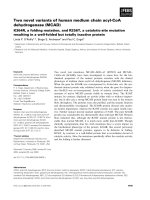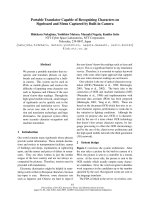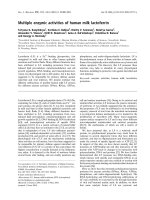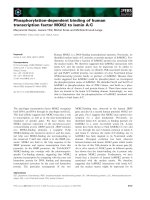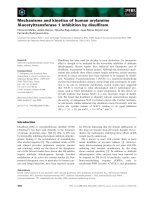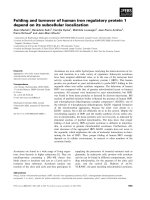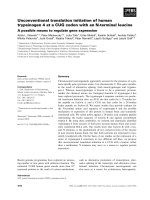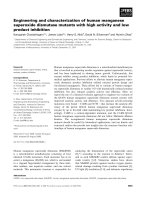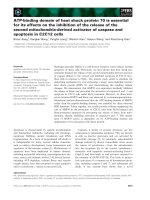báo cáo khoa học: "Sustained complete remission of human epidermal growth factor receptor 2-positive metastatic breast cancer in the liver during long-term trastuzumab (Herceptin) maintenance therapy in a woman: a case report" docx
Bạn đang xem bản rút gọn của tài liệu. Xem và tải ngay bản đầy đủ của tài liệu tại đây (457.43 KB, 4 trang )
CAS E REP O R T Open Access
Sustained complete remission of human
epidermal growth factor receptor 2-positive
metastatic breast cancer in the liver during
long-term trastuzumab (Herceptin) maintenance
therapy in a woman: a case report
John Syrios
*
, Anna Dokou, Nicolas Tsavaris
Abstract
Introduction: This case report and short review discusses how long trastuzumab should be continued in
metastatic breast cancer, the safety issues in case of pregnancy and the risk of relapse with trastuzumab cessation.
Case presentation: We present the case of a 34-year-old Caucasian woman with human epidermal growth factor
receptor 2-positive metastatic breast cancer in the liver who achieved prolonged complete remission within six
months of receiving trastuzu mab (Herceptin) in combination with vinorelbine and gemcitabine. The patient
remains in complete remission seven years later and continues to receive trastuzumab as maintenance therapy.
Conclusion: Trastuzumab-based therapies have greatly improved the survival rates of patients with human
epidermal growth factor receptor 2- positive metastatic breast cancer. Despite such improvements, the safety of
trastuzumab administration during pregnancy is yet to be defined.
Introduction
The development of trastuzumab (Herceptin), a huma-
nized human epidermal growth factor receptor 2
(HER2) monoclonal antibody, has changed the natural
history of HER2-positive breast cancer, providing super-
ior s urvival benefits in combination or as monotherapy
compared with nontrastuzumab-based therapy [1,2].
However, HER2-positive metastatic breast cancer (MBC)
is an aggressive disease, and despite these advances, the
majority of patients treated with trastuzumab -based
regimens progress within one year, with only very few
patients experiencing prolonged remission [3].
Thecasereportpresentedheredescribesawoman
who u nderwent a mastectomy for invasive ductal carci-
noma and subsequently received trastuzumab in combi-
nation with chemotherapy as treatment for a single
metastatic lesion in the liver. She experienced a
complete response, with disappearance of the hepatic
lesion , and has been receiving maintenance trastuzumab
for seven years. While taking trastuzumab, the patient
expressed her intention of starting a family, which raised
a number of questions, such as how long maintenance
trastuzumab should be administered and whether, in
this case, treatment should cease.
Case presentation
In February 2001, an otherwise healthy 34-year-old Cau-
casian woman, with no histor y of hormone therapy,
smoking, drinking, or a family history of breast cancer,
presented with a lump in the center of her right breast.
The axillary and neck lymph nodes were not palpably
enlarged.
After breast biopsy and computed tomography (CT) of
the chest and abdomen, the patient underwent a radical
mastectomy. Pathologic examination of the resected spe-
cimens diagnosed H ER2-positive (immunohistochemis-
try 3+), hormone receptor-negative, grade III, invasive
ductal carcinoma of the right breast with two positive
* Correspondence:
Medical Oncology Unit, Department of Pathophysiology, Laikon General
University Hospital, Athens University School of Medicine, Athens 11527,
Greece
Syrios et al. Journal of Medical Case Reports 2010, 4:401
/>JOURNAL OF MEDICAL
CASE REPORTS
© 2010 Syrios et al; licensee BioMed Central Ltd. This is an Open Access article distributed under the terms of the Creative Commons
Attribution License (http://creati vecommons.org/lice nses/by/2.0), which permits unrestricted use, distribution, and reproduction in
any medium, provided the original work is properly cited.
axillary lymph nodes. The size of the primary tumor was
4.3 × 5.5 × 3 cm. She was treated with sequential adju-
vant chemotherapy, four cycles of epirubicin (75 mg/m
2
)
followed by four cycles of docetaxel (70 mg/m
2
). On
completion o f chemotherapy in August 2001, radiation
therapy was administered to the right breast.
In January 2002, after CT, the patient presented with a
single metastatic lesion (diameter, 1.4 cm) in the right
lobe at segment 7 of the liver (Figure 1); no biopsy was
carried out because our patient was unwilling to
undergo such a procedure. Trastuzumab (4 mg/kg load-
ing dose and 2 mg/kg weekly thereafter) in combination
with 5-fluorouracil-leucovorin-methotrexate (600 mg/
m
2
, 100 mg/m
2
, and 60 mg/m
2
, respectively) was started
as first-line metastatic therapy in February 2002 for four
months. The chemotherapy regimen was then changed
to 40 mg/m
2
vinorelbine plus 600 mg/m
2
gemcitabine
on days one and eight in a 21-day cycle and continued
until April 2003.
Reev aluation of the lesion by ultras onography and CT
followed regularly thereafter and showed a complete
response with disappearance of the hepatic lesion within
six months. The complete response was affirmed by
magnetic resonance imaging in December 2003 (Figure
2).Oncompletionofthechemotherapyregimen,the
patient continued to receive maintenance trastuzumab
monotherapy (6 mg/kg every t hree weeks), and she
remains in complet e remission o n maintenance trastu-
zumab (Figure 3).
Throughout this period, the patient was in good
health and led an active life. In 2006, she decided that
she would like to start a family, given that she had regu-
lar menses after completion of the adjuv ant therapy.
However, after being informed about the possible risks
of trastuzumab treatment during pregnancy and t he
chance of relapse afte r trastuzumab withdrawal, she
decided t o continue treatment and not try for children.
She has now had surgical breast reconstruction.
Discussion
Clinical management of MBC remains a significant ther-
apeutic challenge as oncologists balance improvements
in overall survival with patients’ quality of life [4].
Despite more than 30 years of research, MBC remains
essentially incurable, with a median survival time of
approximately two years [4]. The prognosis is poorer in
patients with HER2-positive MBC [5]. Trastuzumab-
based therapies have greatly improved the survival rates
of these patients, with the largest benefits seen when
Figure 1 Computed tomography scan of metastatic lesion in
the liver taken in 2002.
Figure 2 Magnetic resonance imaging scan take n in 2003.The
hepatic lesion has disappeared.
Figure 3 Liver computed tomography scan after trastuzumab
maintenance therapy. The lesion has not reappeared.
Syrios et al. Journal of Medical Case Reports 2010, 4:401
/>Page 2 of 4
treatment is continued at least until disease progression
[1]. Despite such improvements, the safety of trastuzu-
mab during pregnancy is yet to be defined.
Our patient wished to start a family; however, t rastu-
zumab is cl assified as a category B drug and has been
linked to a reduction in amniotic volume (anhydram-
nios) and fetal growth [6]. Thus, we would not encou-
rage patients to continue trastuzumab while pregnant.
However, if trastuzumab is withdrawn, there is the pos-
sibility that disease may relapse. Preclinical data suggest
that previously suppressed tumor growth resumes
rapidly if trastuzumab is withdrawn [7]. Effective treat-
ment of HER2-positive disease t herefore seems to
require prolonged attenuation of HER2 activity, and it is
difficult to define a time point beyond which trastuzu-
mab might not offer additional benefit. Furthermore,
evidence in the literature supports the idea that continu-
ing anticancer treatments as maintenance therapy in
patients in remission or with stable disease may prolong
the disease-free interval [8].
There is an increasing number of case reports describ-
ing patients who experienced long-term remission from
HER2-positive MBC while receiving trastuzumab mainte-
nance therapy [9,10]. The duration of remission in these
cases ranges from four months to eight years, and in all
cases, maintenance therapy was based on trastuzumab.
One of these cases also illustrates the risk of withdrawing
trastuzumab treatment when the patient had experienced
three years of full remission in the liver but relapsed in
the central nervous system within t wo months of with-
drawal of trastuzumab maintenance therapy [9].
Support for the importance of maintaining HER2 sup-
pression is also provided by studies evaluating the use of
trastuzumab beyond progression. Accumulating evi-
dence shows the benefits of trastuzumab beyond pro-
gression, and it has been observed that progressive
disease is not indicative of resistance to trastuzumab
[11-14]. Clinically relevant objective responses to multi-
ple lines of trastuzumab have consistently been observed
in a multitude of prospective and retrospective analyses
[12-14]. Additionally, in studies that have compared
overall survival rates, significant improvements have
been reported in patients continuing trastuzumab-based
therapy beyond progr ession compared with those who
stopped therapy [11,12]. However, because none of
these studies were randomized, there could be a selec-
tion bias associated with the data; thus, randomized
controlled studies are required to confirm the benefit of
trastuzumab in this disease sett ing. Recently, the results
from a phase III randomized study (GBG-26) comparing
trastuzumab and capecitabine (Xeloda) with capecita-
bine alone in patients who progressed during trastuzu-
mab the rapy were r eported [15 ]. Objective response
rates were nearly doubled (48% vs. 27%), and time to
progression extended (8.2 vs. 5.6 months) by the addi-
tion of trastuzumab to capecitabine, compared with
capecitabine alone, without any unexpected toxicity [15].
An important concern of many clinicians regarding
long-term use of trastuzumab is cardiac tolerability
owing to the unexpected high incidence of cardiac
events reported by the early pivotal trials, particularly
when associated with anthracyclines. It is difficult to
compare trials with different end points and eligibility
criteria; however, the understanding of trastuzumab-
related cardiac events has since improved, and the
majority of these events are manageable and reversible.
Extending trastuzumab treatment does not appear to be
associated with an increased risk of cardiac dysfunction.
In studies of trastuzumab treatment beyond progression,
cardiaceventsappeartoberelativelyuncommonand
mostly asymptomatic [13-15].
Conclusion
Beyond our clinical experience, w e predict that a num-
ber of patients (not reported) experience prolonged
remission while r eceiving trastuzumab maintenance
therapy. We propose that t he molecular profile of a
tumor and its biological environment, as governed by
the specific traits of a patient, will influence whether a
patient achieves long-lasting remission on maintenance
trastuzumab therapy. We also speculate that the specific
localization of breast cancer metastases may be a factor
given that many of the cases reported to date are mainly
associated with liver metastases [9,10]. Why this might
be contributory needs additional investigation.
Consent
Written informed consent was obtained from the patient
for publication of this case report and accompanying
images. A copy of the written consent is available for
review from the Editor-in-Chief of this journal.
Abbreviations
CT: computed tomography; HER2: human epidermal growth factor receptor
2; MBC: metastatic breast cancer.
Authors’ contributions
JS collected and analyzed the data of the study and wrote the manuscript.
AD collected the data of the patient, and NT conceived and designed the
study and supervised the manuscript writing. All authors read and approved
the final manuscript.
Competing interests
The authors declare that they have no competing interests.
Received: 16 December 2009 Accepted: 10 December 2010
Published: 10 December 2010
References
1. Marty M, Cognetti F, Maraninchi D, et al: Randomized phase II trial of the
efficacy and safety of trastuzumab combined with docetaxel in patients
with human epidermal growth factor receptor 2-positive metastatic
Syrios et al. Journal of Medical Case Reports 2010, 4:401
/>Page 3 of 4
breast cancer administered as first-line treatment: the M77001 study
group. J Clin Oncol 2005, 23:4265-4274.
2. Vogel CL, Cobleigh MA, Tripathy D, et al: Efficacy and safety of
trastuzumab as a single agent in first-line treatment of HER2-
overexpressing metastatic breast cancer. J Clin Oncol 2002, 20:719-726.
3. Nahta R, Yu D, Hung MC, Hortobagyi GN, Esteva FJ: Mechanisms of
disease: understanding resistance to HER2-targeted therapy in human
breast cancer. Nat Clin Pract Oncol 2006, 3:269-280.
4. Bernard-Marty C, Cardoso F, Piccart MJ: Facts and controversies in
systemic treatment of metastatic breast cancer. Oncologist 2004,
9:617-632.
5. Slamon DJ, Clark GM, Wong SG, et al: Human breast cancer: correlation of
relapse and survival with amplification of the HER-2/neu oncogene.
Science 1987, 235:177-182.
6. Watson WJ: Herceptin (trastuzumab) therapy during pregnancy:
association with reversible anhydramnios. Obstet Gynecol 2005,
105:642-643.
7. Pietras RJ, Pegram MD, Finn RS, Maneval DA, Slamon DJ: Remission of
human breast cancer xenografts on therapy with humanized
monoclonal antibody to HER-2 receptor and DNA-reactive drugs.
Oncogene 1998, 17:2235-2249.
8. Falkson G, Gelman RS, Pandya KJ, et al: Eastern Cooperative Oncology
Group randomized trials of observation versus maintenance therapy for
patients with metastatic breast cancer in complete remission following
induction treatment. J Clin Oncol 1998, 16:1669-1676.
9. Beda M, Basso U, Ghiotto C, Monfardini S: When should trastuzumab be
stopped after achieving complete response in HER2-positive metastatic
breast cancer patients? Tumori 2007, 93:491-492.
10. Maciá Escalante S, Rodríguez Lescure Á, Pons Sanz V, et al: A patient with
breast cancer with hepatic metastases and a complete response to
herceptin as monotherapy. Clin Transl Oncol 2006, 8:761-763.
11. Antoine EC, Extra JM, Vincent-Salomon A, et al: Multiple lines of
trastuzumab provide a survival benefit for women with metastatic
breast cancer: results from the Hermine cohort study [abstract]. EJC
Suppl 2007, 5:213.
12. Stemmler HJ, Kahlert S, Siekiera W, Heinrich B, Heinemann V: Trastuzumab-
based therapy beyond disease progression for HER2 overexpressing
metastatic breast cancer [abstract]. Presented at the Annual Meeting of the
Deutschen, Österreichischen und Schweizerischen Gesellschaften für
Hämatologie und Onkologie Hannover, Germany; 2005.
13. Tripathy D, Slamon DJ, Cobleigh M, et al: Safety of treatment of
metastatic breast cancer with trastuzumab beyond disease progression.
J Clin Oncol 2004, 22
:1063-1070.
14. Fountzilas G, Razis E, Tsavdaridis D, et al: Continuation of trastuzumab
beyond disease progression is feasible and safe in patients with
metastatic breast cancer: a retrospective analysis of 80 cases by the
Hellenic Cooperative Oncology Group. Clin Breast Cancer 2003, 4:120-125.
15. von Minckwitz G, Zielinski C, Maarteense E, et al: Capecitabine vs.
capecitabine + trastuzumab in patients with HER2-positive metastatic
breast cancer progressing during trastuzumab treatment: The TBP phase
III study (GBG 26/BIG 3-05) [abstract]. J Clin Oncol 2008, 26(suppl):47.
doi:10.1186/1752-1947-4-401
Cite this article as: Syrios et al.: Sustained complete remission of human
epidermal growth factor receptor 2-positive metastatic breast cancer in
the liver during long-term trastuzumab (Herceptin) maintenance
therapy in a woman: a case report. Journal of Medical Case Reports 2010
4:401.
Submit your next manuscript to BioMed Central
and take full advantage of:
• Convenient online submission
• Thorough peer review
• No space constraints or color figure charges
• Immediate publication on acceptance
• Inclusion in PubMed, CAS, Scopus and Google Scholar
• Research which is freely available for redistribution
Submit your manuscript at
www.biomedcentral.com/submit
Syrios et al. Journal of Medical Case Reports 2010, 4:401
/>Page 4 of 4
